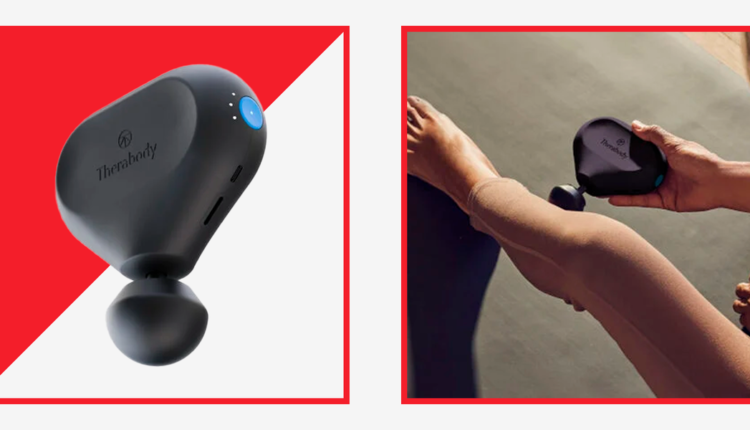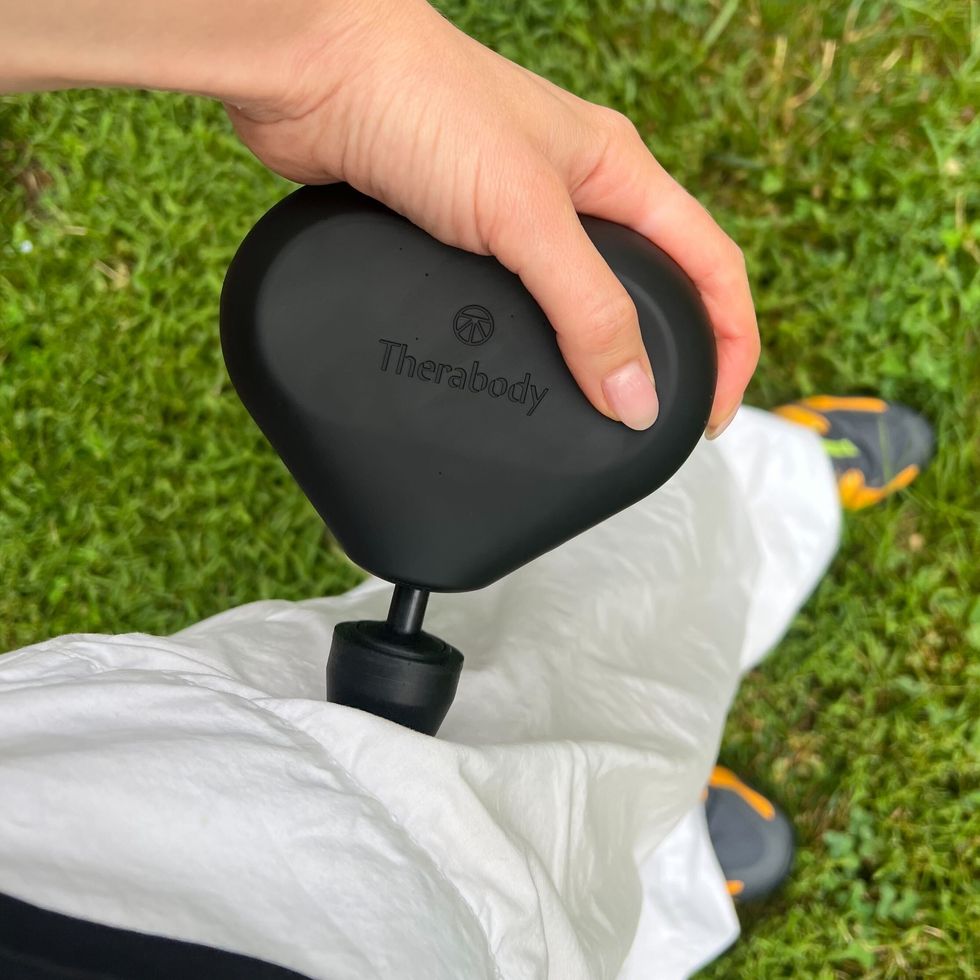STAYING CONSISTENT with training is tough for me when summer travel and socializing ramp up. Thanks to a multitude of factors when I’m off my routine and away from home, I find recovery tends to suffer first.
Just when I needed it the most, I got my hands on the Theragun Mini for a full month of intense testing. I’d just started a new 6-week program using the Caliber app to put on some muscle and give my recent hot yoga obsession a rest, and I was feeling it. So, I put this thing to the test to see if it could keep up with my recovery demands on the go.
The main pull of this massage gun is its portability. Could it really fit in my purse or fanny pack? Yes and yes, leaving plenty of space for other essentials, too. I was even able to slip it in my laptop sleeve on the days I didn’t feel like bringing a bag to work. Plus, it doesn’t weigh much (less than 1.5 pounds), so I didn’t hesitate to throw it into my already stuffed checked luggage without fear of tipping the scale.
On the morning before a flight to Colorado, I hit the gym for a heavy leg day highlighting the deadlift, which I haven’t done all summer. I was worried I’d be sore as hell, especially after my 6-hour flight, but I didn’t want to let slip the program I’d started just a week prior. Naturally, I Theragunned the whole car ride to the airport. When I hopped off my flight in Denver, I wasn’t nearly as stiff as I thought I’d be. High altitude tends to make me feel like I got hit by a bus no matter how I prepare, but this time it was different.
I found the Mini to be a solid travel buddy, saving me from soreness in places I wouldn’t have bothered schlepping my Theragun PRO (which I’ve used weekly for the past two years). Bringing the Mini along on trips served as a little extra nudge to stay consistent with my training, knowing I had a tool on-hand to help keep me grounded in the self-care routines I maintain at home. After a long flight and a 40-mile bike ride at elevation in Breckenridge, CO, the Mini came in clutch for a little R&R to get me back on my feet in time for my dinner plans. Not to mention, the next day, I woke up with way less soreness than I expected–I was ready to take Day 2 of my vacation head on.
Despite its smaller size, the Theragun Mini is solidly constructed, and doesn’t compromise on the premium feel Therabody is known for. Its durability is rock-solid. I put it through the wringer, banging it around during travel and daily use. When I’ve done the same thing to cheaper massage guns, scuffs and dings have surfaced quickly. But the Mini fared better: After a month of usage, its single button still responds efficiently, its pulse is as strong as ever, and its rubberized exterior is free of any scratches.
Throughout my month getting to know the Mini, I zeroed in on specific muscle groups to see how its performance compared to the PRO. To get a fair assessment, I put the Theragun Mini and my Theragun PRO side-by-side. With an extra hand from my partner, we put each device to the test (Mini on the left, PRO on the right, or vice versa), working through bilateral muscles one by one. We took aim at my traps and lower back for everyday tightness (I blame long hours hunched over my keyboard). And went all out on my quads and calves to tackle the post-workout soreness my new program had bestowed to me.
As a long-time user of the PRO, I was skeptical of the Mini’s ability to deliver the same powerful massage. But it blasted those doubts away. Despite its smaller amplitude (12 mm for the Mini, 16 mm for the PRO), I didn’t feel any drop-off in massage intensity. Reality is, you can adjust the depth by applying more or less pressure with the device against your body to compensate for the slight difference in amplitude if you need to. When I asked Bespoke Treatments Co-Founder Dan Giordano, D.P.T., C.S.C.S., for his opinion on the Mini, he mentioned being surprised by the punch it packs. Because it’s so compact, he recommends keeping it bedside to use right before sleep, which has the potential to activate the body’s parasympathetic system, assisting with inducing sleep, promoting relaxation, and facilitating recovery.
SHOP ALL THERAGUN MASSAGERS HERE
When it comes to getting relief from tightness and soreness with massage guns, it’s less about power and more about finding that sweet spot. While the PRO comes with six interchangeable heads to help you hit just the right spot, the Mini only comes with three. In a way, it’s a relief to not have so many interchangeable heads, though, because I don’t need to keep track of them. And the ones included with the Theragun—the Thumb, Standard Ball, and Dampener—hit all the notes that I needed.
The Mini’s three speed settings were simple to navigate, even for someone like me who’s accustomed to the PRO’s wider range of intensities. Throughout my testing, I found myself gravitating toward the lowest two speeds, which provided a satisfying massage–one that got into the sweet spots in my muscles with just enough power. The third setting was a bit too intense for my liking, resulting in more ‘ouch’ than ‘ahhh’ on my most tender muscles. I do wish the Mini’s speed settings offered a more gradual transition between speeds–the PRO’s five speeds progress more smoothly.
While it didn’t match the PRO’s soft tissue release at the highest settings, it still did more than enough to have me feeling ready for the next day’s activities. My quads get insufferably tight–it usually takes a few minutes per side with the PRO on its third-highest setting to loosen them up. So, I worried the first time I used the Mini after squats that I’d still be hobbling to dinner, but that stiffness dissolved after a couple of minutes on the second-highest speed. I never found myself needing to swap the Mini for the PRO for more juice.
Which brings me to my next point, and it’s an underrated aspect—the Mini’s weight and balance. It’s way lighter, more balanced, and overall feels more natural in hand compared to its big brothers (or sisters, you get the point). The PRO weighs 2.8 pounds, while the Mini weighs less than 1.5 pounds. This may not sound like much of a difference. But when you’re using it on your shoulders after an upper body lift and your arms already feel heavy as hell, you’re going to appreciate that lighter device.
Another one of the pleasantly surprising features of the Mini is its battery life. Even with daily usage of 15-20 minutes straight, it managed to last me a full week before needing a recharge. (Both models promise up to 150 minutes per charge.) This reliability was a game-changer on my travels, as I didn’t even bother packing the Mini’s charger on most occasions.
Theragun solved a lot of problems with the Mini. But one they didn’t solve is the noise level. I wish I could bring it to work because it actually is portable enough, but actually is portable enough, but it’s also so loud that you’ll draw plenty of stares if you use it in a quiet office or on an airplane.
While it may not replace the Theragun PRO in terms of attachments and intensity, the Theragun Mini more than compensates with its portability. Its combination of power, portability, and battery life make it worth every penny for active folks who crave that self-care ritual no matter where they are.
Best Massage Guns | Best Massage Guns on Amazon | Best Compression Boots | Best Ice Bath Tubs | Best Recovery Slides and Sandals
Fitness and Commerce Editor
Talene Appleton is the Fitness and Commerce Editor at Men’s Health, a NASM-CPT certified trainer, and former professional dancer and chef. With a background in fitness, nutrition, and culinary arts, her passion lies in inspiring others to lead healthy lives through engaging and research-driven content. You can find her work elsewhere at The Food Institute, The Nessie, and other outlets.
Dan Giordao, D.P.T., C.S.C.S., is the co-founder of Bespoke Treatments, which specializes in sports and orthopedic rehab with an emphasis on manual therapy and strength and conditioning. He’s worked on medical teams at the USA track and field Olympic trials and the IAAF track and field world championships.



Comments are closed.